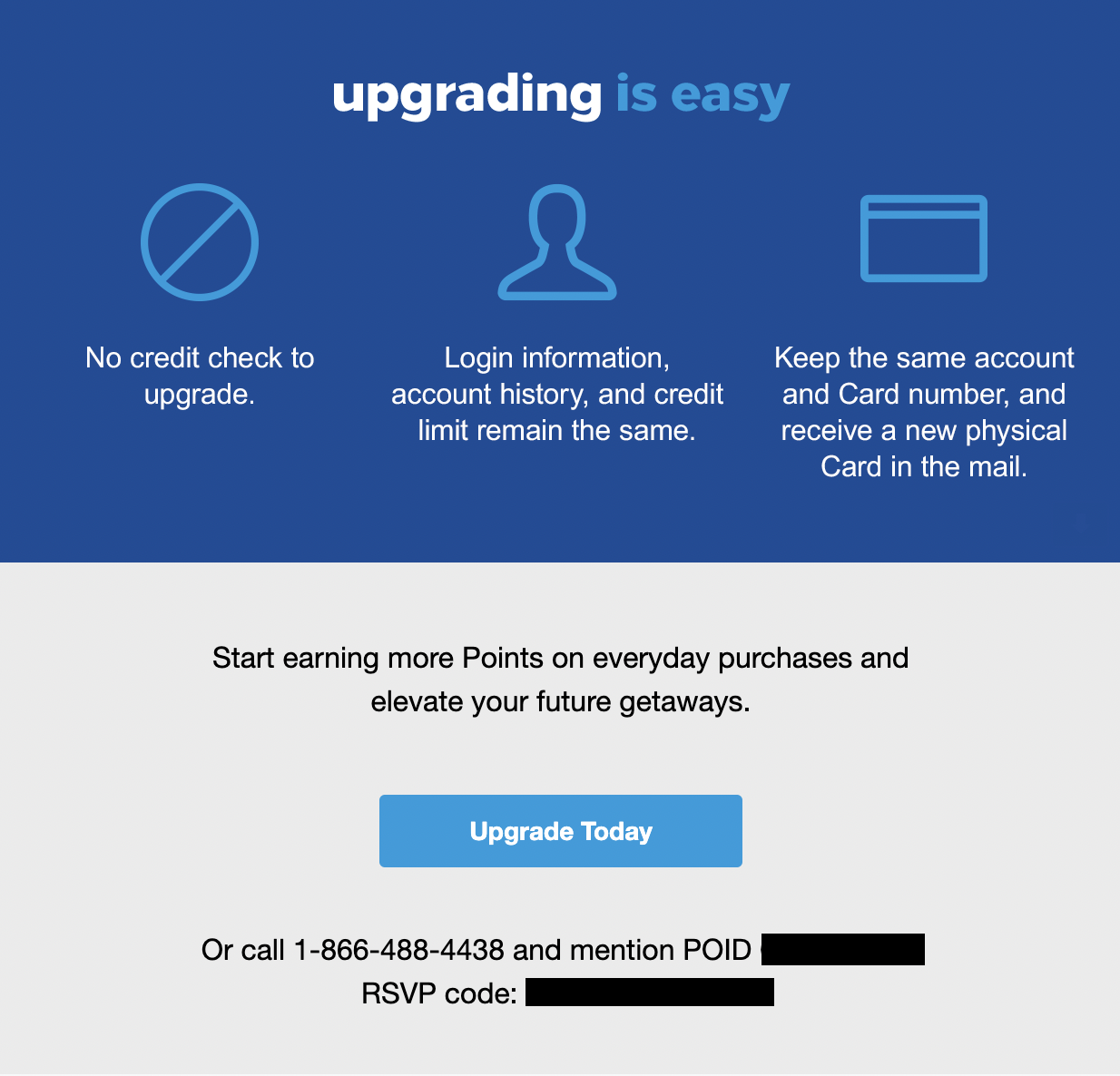American Express in the United States only allows cardmembers to get a welcome bonus once on any given card.
This policy, known as the once-in-a-lifetime rule, would make the pursuit of Miles & Points on the US side unsustainable for people who have been in the game long enough to get most Amex cards south of the border.
As an exception to the rule, however, American Express occasionally sends out targeted upgrade offers to card members who have held an entry-level or mid-tier card for a year or more.
Amex US Upgrade Offers
Upgrade offers function like product switches, but restricted to a single card family. They are a powerful way for seasoned Miles & Points enthusiasts to keep earning big bonuses on Amex US cards.
For instance, somebody who has a no-fee Hilton Card may receive a proposition to upgrade it to the Hilton Surpass Card and get 150,000 Hilton Honors points upon meeting the minimum spending requirement. The bonus would apply even if the cardholder had held the Surpass in the past.
Targeted upgrade offers are typically delivered via email with a dedicated offer code. Cardholders might also see upgrade offers show up on their Amex Offers dashboard.


To benefit from as many signup offers as possible, there are a few key points to remember when deciding whether to accept a targeted upgrade offer, taking into account the nuances of Amex US’s once-in-a-lifetime rule.
Upgrading Amex US Cards
The goal of an optimal upgrade strategy is to receive more than one welcome bonus on every eligible card product. To make that possible, a cardmember should already hold or have held the card that they are upgrading to.
Say a person has the Amex US Gold Card, and that’s the only product they have ever had with American Express US. Suppose they receive an upgrade offer to the Amex US Platinum Card after paying the second year’s annual fee on the Gold.
Even if the targeted offer does not have the once-in-a-lifetime language in the terms and conditions, once the upgrade is processed, the cardmember locks themselves out of getting the publicly available offer on the Platinum Card in the future, which does have the lifetime language in the rules.
In other words, one should never upgrade to a card they don’t currently hold or have never held before.
In this example, if the cardholder truly didn’t want to let the Platinum Card upgrade offer slip through their hands, they could apply for the Platinum Card first and then accept the upgrade offer, so that they do not lock themselves out of a future welcome bonus when applying directly.
Downgrading Amex US Cards
Upgrading equates to paying a higher annual fee in exchange for a welcome bonus. Given the outsized value of the points, upgrading makes sense. But after a customer has held the upgraded card for 12 months, they’d be on the hook for another year’s annual fee.
Unless the card provides enough benefits to cover that second fee, it may be worth downgrading back to a lower-tier product, preferably one with no annual fee – with a view of taking advantage of an upgrade offer a few more years into the future.
The downgrade functions like a product switch without a welcome bonus attached. It’s a means to avoid paying high annual fees on premium cards, like the Platinum Card or the Delta Reserve.
The rule with downgrading, much like with upgrading, is that one should never downgrade to a card they don’t currently hold or have never held before.
If a person who had the Hilton Surpass Card upgrades it to the Hilton Aspire Card, and then downgrades to the no-fee Hilton Card, they are locking themselves out of the welcome bonus on the no-fee Hilton Card in the future.
Indeed, more often than not, it makes sense to pay a second annual fee on a premium card than to miss out on the welcome bonus of a lower-tier product.
Continuing with the Hilton Aspire example, the US$450 annual fee is offset by instant top-tier Hilton Diamond status, a Free Weekend Night Reward, and up to US$500 in travel credits (US$250 airline incidental credit per calendar year and US$250 Hilton resort credit per membership year).
Taken together, those are worth hundreds of dollars for a frequent traveller. With the missed 100,000 Hilton Honors points from the no-fee card on top, downgrading would actually have a negative yield in the long run despite the instant savings of US$450.
If this cardholder truly wished to downgrade, they’d apply for a no-fee Hilton Card first to capture that welcome bonus, before initiating the downgrade so that they don’t lock themselves out of the bonus.

Eligible Upgrade & Downgrade Paths
American Express only allows upgrades and downgrades within the same card “families”, of which there are five.
Hilton Honors personal cards
Amex US offers three co-branded personal Hilton cards with corresponding annual fees: the Hilton Card (US$0), Hilton Surpass (US$95), and Hilton Aspire (US$450). A cardmember may upgrade or downgrade between them in any order.
Switching to or from the Hilton Business Card is not allowed.
With three very useful cards in the lineup, the Hilton family of cards is perhaps where the upgrade and downgrade strategy can be most lucrative in the long run.
Once an individual has gotten all three personal cards, they may “park” all three cards at the no-fee Hilton Card and wait for meaningful upgrade offers to the Surpass or Aspire. Alternatively, they may choose to keep one of the cards as an Aspire at all times, so that they continue to benefit from ongoing Hilton Diamond status.
Marriott Bonvoy personal cards
The only Marriott card available for new applicants is the Bonvoy Brilliant Card with a US$450 annual fee. For downgrades, Amex offers a basic Bonvoy Card with a US$95 annual fee, no welcome bonus, and an anniversary Free Night Award worth 35,000 Bonvoy points.
There are both successful and unsuccessful reports of product switching to this card. In case the customer service agent does not oblige, it may be best to hang up and call again.
Similarly to Hilton Business, the Amex US Bonvoy Business Card is not eligible for upgrades or downgrades.
Membership Rewards charge cards
The personal Green Card (US$150), Gold Card (US$250), and Platinum Card (US$695) may be switched among each other in any order.
The business card lineup supports upgrades and downgrades as well, among the Business Green Card (US$95), Business Gold Card (US$295), and Business Platinum Card (US$595).
Product switching is allowed within the personal and business families, but not between personal and business cards.
EveryDay Cards
Amex does not offer no-fee charge cards in the Membership Rewards family. Instead, cardholders may “park” their US MR points at no extra cost with the EveryDay Card or EveryDay Preferred Card, between which cardholders can upgrade or downgrade freely.
Despite being part of separate families to the personal and business Green, Gold, and Platinum cards, the EveryDay Card or EveryDay Preferred Card can hold MR points accumulated on any card, since Amex US links all Membership Rewards accounts automatically.
The Blue Business Plus is the no-fee small business counterpart to the EveryDay. It is a standalone card that has no upgrade or downgrade options.
Delta SkyMiles cards
The last major credit card family is made up of co-branded Delta SkyPesos SkyMiles cards.
The personal lineup consists of four card products: Delta SkyMiles Blue (US$0), Gold (US$99), Platinum (US$250), and Reserve (US$550).
On the business side, there is no Blue card, with the Delta SkyMiles Business Gold, Platinum, and Reserve having largely the same benefits and annual fees as their personal counterparts.
Just like Membership Rewards charge cards, Delta SkyMiles products may only be upgraded and downgraded within the personal and business families, and cannot be switched between personal and business variants.
Conclusion
Upgrading and downgrading cards is the optimal strategy to maximize repeated bonuses with American Express US. It’s an advanced technique useful to those who have already sampled the scope of Amex US’s offerings are on looking to build upon their once-in-a-lifetime signup offers.
While reasonably straightforward on paper, upgrading and downgrading with Amex US requires careful planning to ensure that the cardmember doesn’t accidentally lock themselves out of a new welcome bonus on a product they haven’t held before.
Furthermore, this practice is best applied in moderation and limited to around one or two upgrade offers per year, as American Express US is known to be quite unforgiving to those who are overly aggressive with maximizing credit card bonuses south of the border.



















Is it possible upgrade from Amex Aeroplan reserve card to Amex platinum card?
Any behavior in particular promotes the reception of these great upgrade offers? I’ve never gotten a single one despite managing a few Gold cards and no-fee Hilton cards for a couple years now.
My Hilton Card upgrade offer didn’t come in until holding the card for ~30 months. Seems like you’ve just gotta wait for it.
P2 had a 25k upgrade offer on her ED to the EDP earlier this year. I think it appeared under AMEX Offers. She applied for a new EDP which went under review. The upgrade offer disappeared as soon as she submitted the new app.
This is my concern because the upgrade offers that are on the dashboard only have no expiry and can disappear at any time.
The emails offers can disappear too. I had a Biz Gold last year and I received an upgrade offer to the Biz Plat around October which has an expire date of April 2021. I applied for a new Biz Plat at the start of December. I clicked on the link in email for the upgrade offer around mid December and it said the offer is no longer available.
Does the following mean that I would “signup” for all three then downgrade them all to the no fee and wait for upgrade offers? Meaning you’d have three of the same product at the same time potentially?
“they may “park” all three cards at the no-fee Hilton Card”
You may of course do that, but don’t forget about the added complexity of managing three separate Hilton trains and the chance that Amex won’t offer you an upgrade on any single one of them.
Thanks Alex! I’ve just been approved (like today) for my first US credit card (Hilton, no fee – was too short of time for the Bonvoy Brilliant 🙁). Your article will help me plan for future actions.
My understanding is offers received via email have an expiry whereas the ones you see on the dashboard do not. I heard if you’re going to double dip you should meet the MSR on the new app first *before* accepting the upgrade offer. As someone who’s current upgrade offer is on the dashboard only (no email received) my concern is what if the offer disappears while you are still working on the first card’s MSR? You’re out of luck. Can you confirm/deny it’s necessary to meet the new app’s MSR before accepting the upgrade offer?
I have a recent DP on this: I received an upgrade offer on my Hilton Card to the Hilton Surpass, applied for and got approved for a new Hilton Surpass, and then accepted the upgrade offer (without having met the MSR on the newly-approved card). I’ve now gotten both the welcome bonus and the upgrade bonus.
Impeccable timing of this article, as I recently double dipped the bonuses on a Bonvoy Brilliant app and upgrade offer on the basic Bonvoy card.